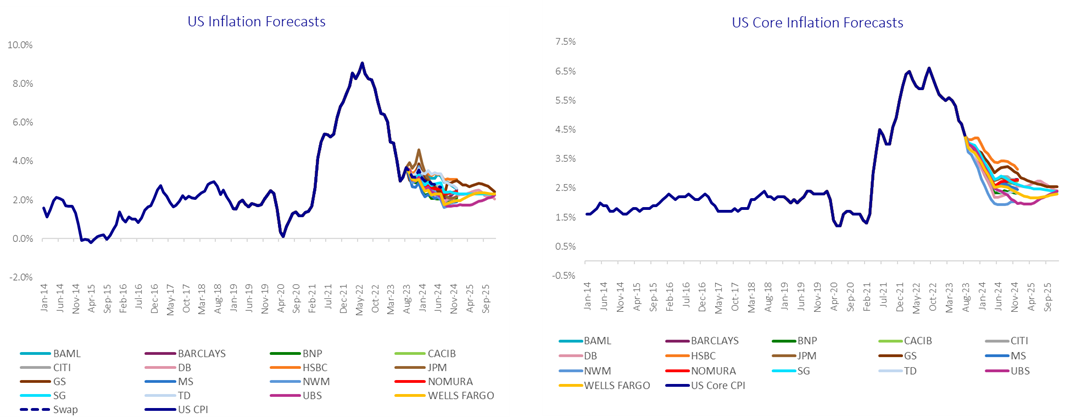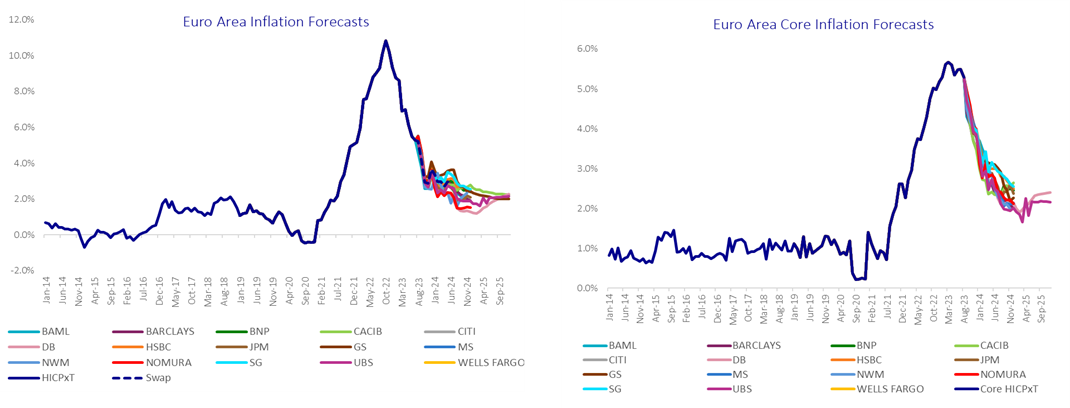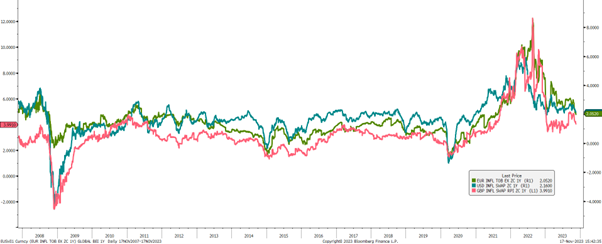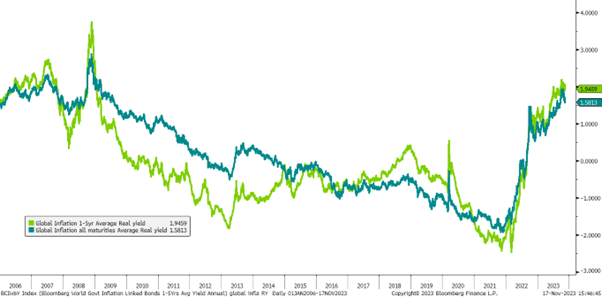
Why consider inflation-linked bonds in a stabilising rates environment
Key points:
- While rates are expected to stabilise, inflation remains historically high and above central banks’ 2% target.
- Why investors may want to re-evaluate their inflation-linked bond allocation.
- What inflation-linked bonds offer in this market environment.
Softer economic data and hawkish messages from central banks have led markets to expect a pause in rate hikes. If rates are stabilising, what does this mean for the inflation-linked bond asset class?
Investor behaviour often means that inflation-linked bonds see strong inflows as inflation takes off and then sharp outflows when nearing the peak regardless of what the inflation level is. This current inflationary cycle has been no different and investors began moving away from inflation-linked bonds towards the end of 2022 as the headline inflation peak was anticipated. This trend continues today. The challenge for investors, however, is that inflation is still high even by historic standards. Despite the lower-than-expected outcomes for inflation in October, core inflation remains elevated. Alongside this, any measure is still above central banks’ 2% target with growth data not yet weak enough to realistically expect inflation to fall back to this target level.
Inflation is sticky and we expect it may be a problem for the next decade. Factors that might see inflation remaining sticky such as the green revolution, the recent “onshoring” trend and budget deficit concerns mean inflation levels could remain volatile for the foreseeable future.
Nevertheless, as the charts below shows, economists are still projecting a return to around the 2% target levels by the end of 2024 and inflation to remain above pre-covid levels particularly in the Euro Area


Source: AXA, Bloomberg as of September 2023
Added to this, market-based inflation expectations for next year are very close to 2%, well below the economists’ and central banks’ forecasts. As the chart below shows, long term inflation breakevens suggest that the market is pricing future inflation at similar levels to those seen between 2010 and 2013.
USD, GBP and EUR Swap rates

Source: AXA IM, Bloomberg as at 17th November 2023
Market conditions offering opportunities
The yield curve remains inverted and this has, historically, been followed by a yield rally: market signals are making a stronger case for duration than we’ve seen for a while. Considering this expectation of a duration rally once core inflation turns, adding duration as core inflation rolls over may be an interesting opportunity.
When inflation moderates, inflation breakevens tend to go down as it has been the case in the past month. This combination of elevated levels of real yields and moderate level of breakevens is where we see opportunities. Inflation-linked bonds’ average real yields are currently at their highest average level since 2009-2010 but they are positive suggesting that investors can lock-in an above inflation income.
Global Inflation Average Real Yields

Source: AXA IM, Bloomberg as of 17 November 2023
We believe that the combination of this with the market complacency towards future inflation risks suggests that inflation-linked bond investors may be able to lock-in positive real yields at their highest level post Lehman while getting exposure to inflation breakevens, (effectively a form of insurance premium against future inflation) at historically attractive levels.
With inflation likely to be volatile for the foreseeable future, inflation-linked bonds may be a useful tool for investors because they should provide resilience against sticky inflation. As all inflation-linked bonds cashflows are also indexed to inflation, and their issuers are often highly rated sovereigns, investing in inflation-linked bonds may be used as part of an investor’s capital preservation strategy.
Disclaimer
BNP Paribas Group's acquisition of AXA Investment Managers was completed on 1 July 2025, and AXA Investment Managers is now part of BNP Paribas Group.
This website is published by AXA Investment Managers Asia Limited (“AXA IM HK”), an entity licensed by the Securities and Futures Commission of Hong Kong (“SFC”), for general circulation and informational purposes only. It does not constitute investment research or financial analysis relating to transactions in financial instruments, nor does it constitute on the part of BNP Paribas Asset Management or its affiliated companies an offer to buy, sell or enter into any transactions in respect of any investments, products or services, and should not be considered as solicitation or investment, legal, tax or any other advice, a recommendation for an investment strategy or a personalised recommendation to buy or sell securities under any applicable law or regulation. It has been prepared without taking into account the specific personal circumstances, investment objectives, financial situation, investment knowledge or particular needs of any particular person and may be subject to change at any time without notice. Offering may be made only on the basis of the information disclosed in the relevant offering documents. Please consult independent financial or other professional advisers if you are unsure about any information contained herein.
Due to its simplification, this publication is partial and opinions, estimates and forecasts herein are subjective and subject to change without notice. There is no guarantee such opinions, estimates and forecasts made will come to pass. Actual results of operations and achievements may differ materially. Data, figures, declarations, analysis, predictions and other information in this publication is provided based on our state of knowledge at the time of creation of this publication. Information herein may be obtained from sources believed to be reliable. AXA IM HK has reasonable belief that such information is accurate, complete and up-to-date. To the maximum extent permitted by law, BNP Paribas Asset Management, its affiliates, directors, officers or employees take no responsibility for the data provided by third party, including the accuracy of such data. This material does not contain sufficient information to support an investment decision. References to companies (if any) are for illustrative purposes only and should not be viewed as investment recommendations or solicitations.
All investment involves risk, including the loss of capital. The value of investments and the income from them can fluctuate and that past performance is no guarantee of future returns, investors may not get back the amount originally invested. Investors should not make any investment decision based on this material alone.
Some of the services listed on this Website may not be available for offer to retail investors.
This Website has not been reviewed by the SFC. © 2026 BNP Paribas Asset Management. All rights reserved.